:::::::::::::::::::::::::::::::::::::::::::::::::::::::::::::::::::::::::::::::::::::::::::::::::::::
Target (mato) - Japanese Archery
***** Location: Worldwide
***** Season: Non-seasonal Topic
***** Category: Humanity
*****************************
Explanation
The Target of Archery, when you hit it ! The bull's-eye!
"hit the bull's eye" or "hit the mark"
xxxxxxxxxxxxxxxxxxxxxxxxxxxxx
The discussion evolved from this haiku by a friend, quoted below:
sudden shower!
each raindrop
a bull's-eye
He explains:
As I was walking to work, there were puddles. I noticed the rings that each of the raindrops made on the surface of the puddles reminded me of the concentric rings of an archery target (at least USA archery targets, which have concentric rings the middle being called, "the bull's eye". Thus and so, the haiku formed in my heart then in my head then in my hand.
Now, to translate that feeling into English, I tried. I also tried to translate that feeling into Japanese, but, not necessarily from the English, but in my "Japanese" heart from what limited little I know and have experienced of Japan. I do not know about archery targets in Japan. I do not know any other meanings about the center of targets from any other direct culture than the USA (perhaps Gabi san, being an archer, can help there).
I do know using a symbol such as "bull's eye" as an idiom is risky in translation. I wanted to learn from this experience. The equivalent word I chose from the online Japanese dictionary for "bull's eye" was kinteki. Though, there were others such as, seikoku. So, I would like to chose one that is the center of a concentric circled target, if there is such.
http://groups.yahoo.com/group/translatinghaiku/message/116
:::::::::::::::::::::::::::::::::::::::::::::::::::::::::::::::::::::::::::::::::::::::::::::::::::::
The Target of Japanese Archery

http://www.geocities.co.jp/Athlete/2074/terms/mean/target.html
The normal target for Japanese archery is 36 cm in diameter, with three concentric circles, called
"mist target", kasumi mato 霞的(かすみまと)
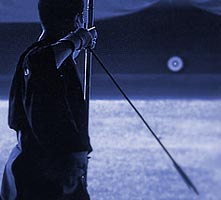
http://www.kyudo.jp/main.html
A target with only one black spot is called
star target, hoshi mato 星的(ほしまと)
This is good for the daily practise and often used in student's clubs.

http://www.geocities.co.jp/Athlete/2074/terms/mean/target.html
A target with concentric colored circles is called
color target, iro mato 色的(いろまと)
It is often used in competitions when fighting for points. The colors are white (3 points), black (5 points), blue (7 points), red (9 points) and gold (10 points) in the middle!
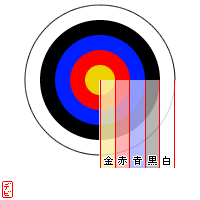
ecoecoman.com/kyudo/kisoku/kisoku03.html
:::::::::::::::::::::::::::::::::::::::::::::::::::::::::::::::::::::::::::::::::::::::::::::::::::::
Practicing Japanese Archery with a straw target (makiwara 巻藁)
You stand only at a little more than arm's lenght away from this target and can concentrate on the movements of your body whilst shooting. Japanese Archery is sometimes called "Zen in Action" and the makiwara is your best friend in that pursuit.
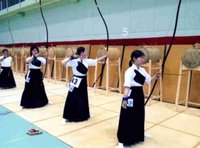
http://www.jttk.zaq.ne.jp/kawanishihabatan/pc/Calendar.html
:::::::::::::::::::::::::::::::::::::::::::::::::::::::::::::::::::::::::::::::::::::::::::::::::::::
Zen and the Art of Archery
By Kit Alderdice、2002
http://users.erols.com/kenrawie/washpost020329.html
:::::::::::::::::::::::::::::::::::::::::::::::::::::::::::::::::::::::::::::::::::::::::::::::::::::
真善美 - Shin, Zen, Bi: Saying it another way
Excerpt of article from the Oxford Brookes University website
(may be accessed through Kyudo Articles/Documents-What is Kyudo?)
The highest ideal of kyudo practice is the realization of shin, zen, bi - truth, goodness, and beauty. These values are not simply cultural but are really understood more as something spiritual (naturally inherent) that finds form in human expression. This is important because shin, zen, bi is not simply something to cultivate and see as self-created but as the expression of qualities that emanate from our deeper self.
Shin means the absolute truth of things as they are. Although the form and conditions may appear to change, truth does not. Practice must be based in a trust and faith in truth.
Zen means moral goodness but in kyudo it also means the honesty of purpose to seek for the “rightness” of action that emanates from truth. When action is based in shin, with the purpose of zen, then it has a dignity and quality of appearance that is appealing and beautiful to observe.
This is the expression of bi.
.
source : 14kyudo.wordpress.com
:::::::::::::::::::::::::::::::::::::::::::::::::::::::::::::::::::::::::::::::::::::::::::::::::::::
*****************************
Worldwide use
Poland
"bull's-eye" is not used in Polish, as in Japanese, we just call it "srodek tarczy" - "middle of the target".
Grzegorz Sionkowski
*****************************
Things found on the way
Japanese Archery 弓道 The Way of the Bow
© All Nippon Kyudo Federation
Zen Nihon Kyudo Renmei
Kyudo is one of the Japanese martial arts, and is similar to archery.
http://www.kyudo.jp/english/
In Japanese
http://www.kyudo.jp/main.html
How to Shoot with a Japanese Bow
Scroll through the explanations.
http://www.kyudo.jp/sekai/shaho.html
ooo ooo ooo ooo ooo ooo ooo ooo ooo
Some old Japanese Archery Photos
http://www.artsofthesamurai.com/Acker/html/kyudo_old.html
The White Rose Kyudojo, UK
Despite its ostensible esoteric content, Kyudo is not a short-cut to a certain development of mind achieved in other Budo by many years of regular retraining of physical and mental reflexes. Like any other Japanese Budo it is a lifelong study of oneself and is about continuous effort, hard knocks, bitter disappointment and failure and a few moments of ecstatic understanding.
Its purpose is exactly the same as the other mainstream Budo - to produce a well balanced, healthy, long-lived human being with respect for others and a willingness to live positively and usefully in society.
It is not a religion, although some of its forms and beliefs have been influenced by Confucianism, Buddhism and Shinto. Nor is it a practical fighting system although its origins are in hunting and battle; all aspects of killing another living creature have been removed from the training.
Read a lot more about Kyudo here
http://www.japanese-archery.org.uk/kyudo.html
:::::::::::::::::::::::::::::::::::::::::::::::::::::::::::::::::::::::::::::::::::::::::::::::::::::
Look at some arrows that hit the targets (tekichuu 的中)
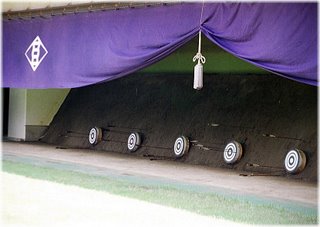
http://bachpartiten.web.infoseek.co.jp/paysage-kyudou.html
:::::::::::::::::::::::::::::::::::::::::::::::::::::::::::::::::::::::::::::::::::::::::::::::::::::
I have been practising Japanese archery for about 30 years now. The bowstring is the best teacher, giving you a good hit and bruises if you are not with your actions.
This kind of physical experience, taiken 体験, is a great help and really transforms to Zen in Action.
A direct physical experience of many things, for example letting go and yet remain (zanshin 残心)... something you have to take over into your daily life.
Real Kyudo practise begins when you leave the dojo, the training hall.
Gabi Greve
*****************************
HAIKU
sudden shower!
each raindrop
a bull's-eye
another version
sudden shower!
in each raindrop
a gold ring
"chibi" (pen-name for Dennis M. Holmes)
Read more here about the Gold Ring Discussion.
xxxxxxxxxxxxxxxxxxxxxxxxxxxxx

春の矢は未来を放ち 山笑う
spring arrow
to hit
the future
Read Gabi Greve and the Arrows of Time
xxxxxxxxxxxxxxxxxxxxxxxxxxxxx
Zen archery —
aiming for the bull’s-eye
in my mind
Stanford M. Forrester
http://www.terebess.hu/english/usa/forrester.html
:::::::::::::::::::::::::::::::::::::::::::::::::::::::::::::::::::::::::::::::::::::::::::::::::::::
to hit the target
one becomes the target--
sound of arrow's flight
the distant target
larger than the universe--
arrow's flight
wade german, December 2007
:::::::::::::::::::::::::::::::::::::::::::::::::::::::::::::::::::::::::::::::::::::::::::::::::::::::

source : www.emuseum.jp
Archery Contest
"Shotoku Taishi Eden" 聖徳太子絵伝
Illustrated History of Prince Shotoku
. Imperial Prince Shotoku 聖徳太子 .
(574 - 622)
*****************************
Related words
***** Bow, yumi 弓
***** Arrow, ya 矢
***** Archery, kyudoo (kyuudoo) 弓道
. Archery on Horseback, yabusame 流鏑馬
umayumi 騎射 (うまゆみ) "horses and bows"
and related kigo
. yabitsu ヤビツ /矢櫃 quiver .
:::::::::::::::::::::::::::::::::::::::::::::::::::::::::::::::::::::::::::::::::::::::::::::::::::::
***** Ooyakazu 大矢数 Shooting many arrows
(at Sanjusan Gendo Hall, Kyoto)
yakazu 矢数(やかず)"number of arrows" many arrows
tooshiya 通し矢(とおしや)
sooichi, soo-ichi 総一(そういち)
yumi no tenga 弓の天下(ゆみのてんが)"the Heaven of Archery"
kigo for early summer
Observance Saijiki : Summer
The famous Hall Sanjusan Gendo with 1000 statues of Kannon Bosatsu

Sanjusan Gendo (Sanjuusan Gendoo 三十三間堂, 京都)
http://www.sacred-destinations.com/japan/kyoto-sanjusangendo.htm
. Nishimura Kocho 西村公朝
and the hall Sanjusan Gendo
***** Archery Competition at Sanjusangendo,
tooshiya 通し矢
kigo for early summer
Taditionally, the contest is a ritual exercise intended to show young participants that an adult's life requires patience and self-control.
It used to be a show of the best archers from each domain in the Edo period.
Sometimes a similar ceremony is performed on the New Year.
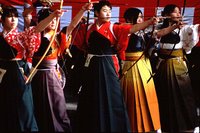
The girls are dressed in their festive kimono and hakama skirts for the occasion. It is an honour to take part in this contest.
Look at many photos.
http://miyako.bufsiz.jp/toosiya/toosiya.html
***** Shooting of the year's first arrow,
hatsuya 初矢
yumi hajime, yumihajime 弓初め first bow shooting
kigo for the New Year
The archer's arrow in flight symbolized the driving away of evil spirits, and that idea was driven home by way of a cleaver trick. Placed just in front of the target was a stand that held a small paper packet. When the archer let his arrow go... it first hit the packet, which exploded into a cloud of white paper confetti symbolizing purity.
Look at some photos and more information
http://www.theblackmoon.com/Kyudo/kyudo.html

Sanjuusan Gendoo in Snow 三十三間堂 Sanjūsangen-dō
Konishi (b.?) - 1980
立像の千体仏も足より冷ゆ
ryuuzoo no sentaibutsu mo ashi yori hiyu
these standing statues
of one thousand Buddhas
get cold from their feet too
Matsumura Masahiroo 松村昌弘 Matsumura Masahiro
The great hall is of course unheated and winter in Kyoto is cold!
.................................................................................
Sanjuusan Gendoo no yooji joosui kaji
三十三間堂の楊枝浄水加持 (さんじゅうさんげんどうのようじじょうすいかじ)
kigo for the New Year
warding off headache with a willow branch at Sanjusan Gendo
During the New Year celebrations, consecrated water is spread on the head of the visitor with a willow branch to ward off a headache for the rest of the year and pray for a healthy family.
This ritual dates back to Goshirakawa Tenno, who suffered from a strong headache. He ad a dream and inspiration, telling him to make a building in the lenght of 33 gen (sanjuusan gen) with the wood of willow trees. When he started the project, his headache was healed !
. . . CLICK here for Photos !
.................................................................................
Imperial Court Rituals for the New Year
noriyumi 賭弓 bow shooting contest
..... noriyumi 賭射(のりゆみ)
keari aruji 還饗(かえりあるじ)
noriyumi no sechi 賭弓の節(せち)
On the 18th day of the first lunar month.
The imperial guards 左右近衛 performed a contest at the imperial stable (yubadono 弓場殿). The winning party was allowed to perform dances, the loosing party was offered sake to drink their fill.
quote
Busha matsuri
Busha sai 奉射祭 or 歩射祭
A sacred archery ritual performed mainly around the New Year.
It can be written with the characters 歩射 or 奉射, and has many variant pronunciations including bisha and hōsha. Performed widely at shrines throughout the country. In contrast to kisha (equestrian archery), busha entails shooting a bow (yumi) while on foot (kachi) and so was also referred to as kachiyumi.
During the Heian period, a two-day archery event was held as a public ritual at the court to mark the start of a new year. The jarai 射礼 shooting ritual took place on the seventeenth of the first month, followed on the morning of the eighteenth day by the noriyumi archery competition.
The term "busha" is also used in the Ryō-no-gige to refer one of the military arts.
The jarai ritual held at the court fell into decline after the Kamakura period and ultimately died out, but those held at the "great shrines" (taisha) in many areas continued for many years after.
source : Takayama Shigeru, Kokugakuin,
. First Court Rituals .
:::::::::::::::::::::::::::::::::::::::::::::::::::::::::::::::::::::::::::::::::::::::::::::::::::::
kigo for late spring
suzume koyumi 雀小弓(すずめこゆみ)
shooting with a small bow
lit. "small bow for sparrows"
koyumi hiki 小弓引 (こゆみひき) drawing a small bow
koyumi asobi 小弓遊(こゆみあそび)playing with a small bow
Used by children for practising archery or by grown-ups for pleasure in the Edo period.

:::::::::::::::::::::::::::::::::::::::::::::::::::::::::::::::::::::::::::::::::::::::::::::::::::::
少年の矢数問寄る念者ぶり
shoonen no yakazu toiyoru nenshaburi
the elder lover boy
enquires after the many arrows
of his younger friend
. Yosa Buson 与謝蕪村 (1715-1783) .
shoonen and nensha have a kind of homosexual relationship.
. . . Discussion on Facebook
.......................................................................
(Buson)
New Year's 1772
I've never seen the cherry blossoms in Yoshino, so I've made up my mind to travel there this spring.
ごたへの雲に花あり弓はじめ
tegotae no kumo ni hana ari yumihajime
my arrow hits
blossoms in the clouds --
year's first archery
The "first archery (literally 'bow') of the year" was an ancient court ritual imitated by the warrior class, but here Buson seems to have visited a Shinto shrine in or around Kyoto at or soon after New Year's to see and apparently participate in a ritual archery contest. Usually such contests were a form of divination, with the result of the arrows shot by the Shinto priest or priests suggesting future events or harvests.
Buson seems to have shot an arrow himself, so perhaps pilgrims to the shrine were able to shoot an arrow after the ritual archery had finished. The word for hit (tegotae) normally means to be right on the mark, to hit the middle of the target if not the bull's-eye, but Buson humorously shifts the meaning: I hit only spring clouds, but somewhere out there beyond them I can barely make out the clouds of cherry blossoms in Yoshino. The cherry blossoms won't bloom for another six weeks, so Buson seems to be looking though time with his divinatory arrow and seeing the vague, misty shapes of cloudlike cherries in blossom in the depths of the clouds. That is, he seems to be making fun of himself or chiding himself. My New Year's resolution is to visit Mt. Yoshino while the cherries are in bloom, but my arrow was a direct hit on a cloud and disappeared into it. In other words, I long to visit Yoshino, but my will is as uncertain and unclear as clouds, so it looks as if I probably won't actually walk all the way to Yoshino this spring.
Buson has a haiga with this hokku and the foreword brushed on it. Below the text is an ink painting of a man wearing the robes of a Shinto priest. The priest has droll smile on his face as he stares up, presumably at the clouds, suggesting he may be Buson's own persona. The forward is written in the style of a dialog in a noh play spoken by the waki character, most commonly a traveling Buddhist priest, so Buson may be representing himself as a Shinto priest who dreams of Yoshino but sees only clouds when he gazes toward Yoshino.
Chris Drake
:::::::::::::::::::::::::::::::::::::::::::::::::::::::::::::::::::::::::::::::::::::::::::::::::::::

source : www.kyudo.com/kyudo-k. Meishin Kyudojo
:::::::::::::::::::::::::::::::::::::::::::::::::::::::::::::::::::::::::::::::::::::::::::::::::::::
Immage frin Musée National des Arts Asiatiques - Guimet
“L’arc et le sabre – Imaginaire guerrier du Japon”
- reference source : guimet.fr/event ... -
This image may be by Baron von Stilfried.
The photo appears as "Archger" on p. 104 of Once Upon a Time: Visions of Old Japan.
Photographs by Felice Beato and Baron Raimund von Stillfried.
The book was originally published in France under title Mukashi, Mukashi 1863-1883, Les Editions Arthaud, Paris, 1984; first published in the USA in 1986 by Friendly Press, in New York.
:::::::::::::::::::::::::::::::::::::::::::::::::::::::::::::::::::::::::::::::::::::::::::::::::::::
SAIJIKI - NEW YEAR
OBSERVANCES
Amulet
. Atariya 当たり矢 arrow to hit good luck .
. yakazu haikai 矢数俳諧 and Ihara Saikaku .
. Amulets for Sports and Martial Arts .
[ . BACK to WORLDKIGO TOP . ]
[ . BACK to DARUMA MUSEUM TOP . ]
:::::::::::::::::::::::::::::::::::::::::::::::::::::::::::::::::::::::::::::::::::::::::::::::::::::







14 comments:
.
kyudoka and sensei -
practising a hundred shots
without bow and arrow
Gabi Greve
::::::::::::::::::::::::::::::::::::::::::::::::::::::::::::::::::::::
Nasreddin brought a bow and arrows with him to the country fair, and his students all came to see their teacher compete in the archery contest.
Like all other contestants, Nasreddin was given three shots at the target. Before he took his first shot, Nasreddin put on the kind of hat a soldier wears and stood up very straight. Then he pulled the bow back hard and fired. Nasreddin missed the target completely, and the crowd laughed mightily at him.
Nasreddin picked up the bow once more and drew it back. This time he used much less strength, and although the arrow flew straight at the target, it fell far short.
Nasreddin had only his third shot left. He simply turned to face the target and fired the third arrow. It hit dead center, and the whole crowd went crazy! Everyone wanted to know how he made the last shot after not even having come close with the first two.
"I'll tell you," Nasreddin said.
"For the first shot, I was imagining I was a soldier and a terrible enemy faced me. Fear caused the arrow to fly high over the target.
When I took the second shot, I was thinking like a man who had missed his first one and was so nervous he could not concentrate. He was weak with worry, and the shot was weak, too."
Nasreddin paused. Finally a courageous soul spoke up. "And what about the third one? Who fired that arrow?"
"Oh," said Nasreddin. "That was me!"
traditional Sufi story
Hello Gabi,
I just read your interesting article "Haiku Time".
http://wkdsaijikieuropa.blogspot.com/2008/04/haiku-time.html
No doubt Gabi, one thing is for sure, you are ahead of time (roger-winks-at-gabi-and-smiles-at-her):
No, honestly, thank you for all your interesting articles and last but not least for your wonderful
Haiku! I just lost myself in your blogs for a few hours instead of working (shame, shame... :)
Even though: Haiku Time doesn't exist.
And you know it.
I'm sure you just made fun of us as this is
nothing new for you of course:
Without the sender no receiver.
Without a Gabi writing no Roger answering.
Without a Kyudoka (subject) no shot, without a shot no target (object).
Without a shot no time.
Did you ever
realize:
Time can only really be understood
(as a concept?) at the point when the
Kuydoka (in your case, in my case the
Graphic Designer) stops to exist. At
this (nonexisting) moment she / he
becomes one with the arrow (of time)
and the target. No difference.
Paradoxically that's also when time
disappears. Completely. No Newtonian Time,
no circular or linear time understanding,
no Haiku Time, no Time at all.
And now, that we finally understand Time,
it is no more (Gabi-and-Roger-looking-at-
each-other-for-a-short-moment-then-
bursting-both-out-laughing)
And then, back in the "here and now"
one wonders, if we have understood
anything at all...
You know, the worst are those guys,
that write you E-Mails just like this one:
thinking they're the supergreat masters
that know it all and can teach you
whatnot without you having asked
them to give you some of their useless
knowledge ( <-- oh, this is Roger making
a little fun of himself ;)
Keep on your beautiful (Haiku-)work, Gabi.
I (yes, there is still an "I" meaning: I'm far
from enlightenment ;) send you warm greetings
from my atelier right across the old cedar
out in the cold,
Roger
Nasreddin brought a bow and arrows with him to the country fair, and his students all came to see their teacher compete in the archery contest. Like all other contestants, Nasreddin was given three shots at the target. Before he took his first shot, Nasreddin put on the kind of hat a soldier wears and stood up very straight. Then he pulled the bow back hard and fired. Nasreddin missed the target completely, and the crowd laughed mightily at him.
Nasreddin picked up the bow once more and drew it back. This time he used much less strength, and although the arrow flew straight at the target, it fell far short.
Nasreddin had only his third shot left. He simply turned to face the target and fired the third arrow. It hit dead center, and the whole crowd went crazy! Everyone wanted to know how he made the last shot after not even having come close with the first two.
"I'll tell you," Nasreddin said. "For the first shot, I was imagining I was a soldier and a terrible enemy faced me. Fear caused the arrow to fly high over the target. When I took the second shot, I was thinking like a man who had missed his first one and was so nervous he could not concentrate. He was weak with worry, and the shot was weak, too."
Nasreddin paused. Finally a courageous soul spoke up. "And what about the third one? Who fired that arrow?"
"Oh," said Nasreddin. "That was me!"
traditional Sufi story
Endless Determination
Many, many years ago Kazu and Hiro were two young boys growing up on the outskirts of Kyoto, and they both loved the art of Japanese archery known as kyudo. While in high school they practiced as much as they could.
Upon graduating Kazu had to quit so he could work in his family's business, making the protective armor worn by samurai during battle. The armor was heavily padded and Kazu joined the pieces together with a sewing machine that had a large wheel used to position the thick needle in the correct location for piercing the fabric. The job was physically demanding and dangerous. If Kazu's mind wandered for just a moment, he could easily pierce his hand instead of the fabric.
snip
When both boys had ripened to become men in their fifties, the Emperor declared a nationwide competition to honor the role and importance of Japan's many fine archers. On his way to the competition Hiro stopped by to see his childhood friend Kazu. He told his friend about the upcoming event, and Kazu sheepishly asked if he could enter the competition being introduced as Hiro's student. Although Hiro thought the proposal somewhat foolish, because of their strong friendship in the past he agreed to bring Kazu along.
With all the masters and their many students present, people were expecting a great display of prowess. With two arrows to shoot, whoever pierced the target twice, would be given a sizeable quantity of gold and a large plot of land. To everyone's surprise though, the target was placed at twice the distance of their everyday practice!
snip
With no official ranking, Kazu was the very last person with a chance to shoot and win the prize. He gathered his spirit, let loose his arrows, and both flew straight and sure piercing the target. Everyone in attendance was speechless as the emperor presented Kazu with his lavish reward.
With the ceremony over Hiro rushed over to Kazu and asked, "After all these years with no practice, how in the world did you manage to hit the target both times?"
“Well," Kazu replied, "As an artisan, countless times a day I aimed to pierce the heavy fabric in just the right spot. I imagined my needle was my arrow, and I must say I hit the target each and every time! Today was no different."
"You see, whether it's been kyudo or work, I've always been aiming at the same target. Myself. In the course of my mundane life I had endless determination and never gave up my dream of fulfilling my true potential. It was this determination that carried the arrows to the target today."
The "Pure Heart, Simple Mind" Newsletter October 2010
Seishindo
http://www.seishindo.org/newsletter.html
Kobayashi Issa
人なつき鶴よどちらに矢があたる
hito natsuki tsuru yo dochira ni ya ga ataru
which one of those
tame cranes
will the arrow hit?
(Tr. David Lanoue)
kabura-ya 鏑矢 Kabura arrow
and
temple
Kaburaiji 鏑射寺 Kaburai-Ji
kaburai, kabura i - lit. "shooting a Kabura arrow"
Hyogo, 兵庫 Kobe 神戸市北区道場町生野1078-1
.
The Kyudo World Cup Championship will be held in the French capital in July.
Kyudo Grand Master Tsuyoshi Sakuma demonstrates the Japanese martial art in Paris.
http://www.kyudo2014.org/
Legends of Japan about bikuni nuns
sennen bikuni 千年比丘尼 a young nun for 1000 years
never growing old, because once she ate the meat of a "human-fish"
In Asakuchi 浅口, Okayama in the hamlet of 貞見 Sadami
there is another tree that has sprouted from her walking stick. It has sprouted, as she had foretold, "tsue wa ikitsuku made" 杖は活き着くまで. . . and now there is another hamlet with a pun on that nearby :
Tsukuma 津熊 .
The tree that sprouted from her stick was a huge yanagi 大柳 willow tree.
It was so strong and perfect that the tree was cut down and its trunck became a beam for the famous 三十三間堂, 京都 Hall of 1000 Buddha Statues in Kyoto, Sanjusan Gendo.
.
There is another legend in Okayama about a willow tree used for the Sanjusan Gendo hall
.
http://darumapilgrim.blogspot.jp/2013/01/ama-buddhist-nun.html
.
In Mie prefecture there is a another story about a huge willow tree for the Sanjusan Gendo Hall.
The roof beams for the hall had to be about 100 meters long and were not so easy to get.
Yooji Yakushi Doo 楊枝薬師堂 The Yakushi Hall of Yoji Village - 浄薬寺Joyaku-Ji
A huge willow tree of the village had to be felled and brought to Kyoto for the Sanjusan Gendo Hall, which was built on request of 後白河上皇 /後白河天皇 Go-Shirakawa Tenno (1127-1192). He had a severe headache all the time and wanted to construct a large temple to pray for healing.
Once the temple was built, the Emperor's headache was healed.
.
Wakayama 和歌山県 ......................................
In a former life 後白河法皇 Emperor Goshirakawa had been a mountain priest named 蓮華坊 Renge-Bo, but he had fallen into a ravine and lost his life. A willow tree grew on the spot, piercing the skull and causing the Emperor a constant headache whenever the wind blew the branches of the tree.
On a pilgrimage to Kumano to get rid of the headache, the Emperor learned of his former life and made a search for the skull. He buried the skull properly and used the willow tree to make a beam of the Sanjusan Gendo hall 柳で三十三間堂の棟木. Other versions say he had a Statue of Kannon made and placed the skull inside to show this greatfulness for being relieves of the headache.
This story is similar to the one of Kazan from Nara, see above.
To our day the temple has an event in January known as the Rite of the Willow (柳枝のお加持), where worshippers are touched on the head with a sacred willow branch to cure and prevent headaches.
.
http://heianperiodjapan.blogspot.jp/2016/05/dokuro-sharekobe-skull.html
.
三十三間堂棟由来
さんじゅうさんげんどうむなぎのゆらい
sanjusangendo munagi no yurai
The House of Heitaro
平太郎住家
The Lumber Carriers' Song
木遣り音頭
Bunraku
http://bunraku.panthorstudios.com/play/the-ridge-pole-of-the-sanjusangendo-temple/
,.
Eugen Herrigel
Zen in the Art of Archery
and an article
Reconsidering Zen, Samurai, and the Martial Arts
Oleg Benesch
http://apjjf.org/2016/17/Benesch.html
.
Zen in der Kunst des Bogenschiessens
.
Legend about a yumi shokunin 弓職人 a craftsman making bows
.
hikigaeru ひきがへる toad
At a place named 関口 Sekiguchi in Edo there was 水神の社 a Shrine for Suijin the Water Deity. Along the river in front of the Shrine there grew a lot of makomo まこも草 wild rice .
Once 弓職人 a craftsman making bows named Yahei 弥兵衛 passed there when he saw some large shining eyes, about as larte as one seating mat. This was a huge toad.
He was so afraid he run home and stayed in bed for seven days.
.
https://edoflourishing.blogspot.com/2020/05/shokunin-craftsmen-legends.html
.
Post a Comment